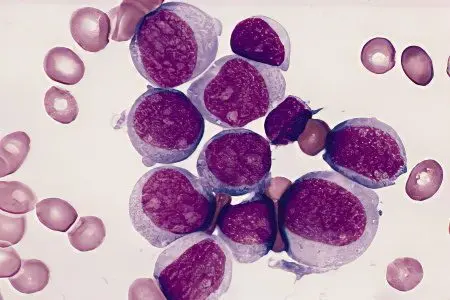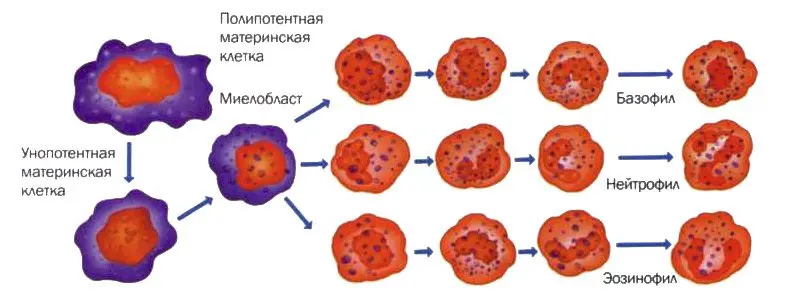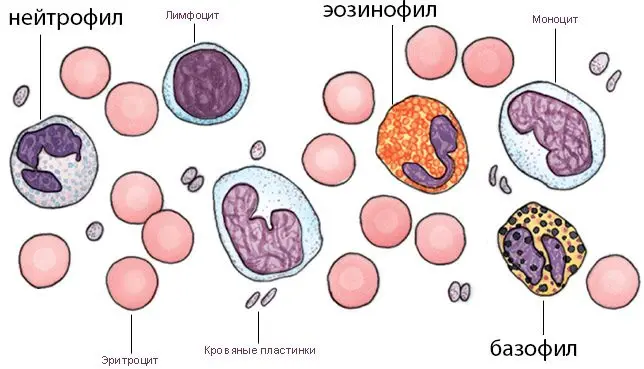Contents

Leukocytes are of two classes – granulocytic and agranulocytic. Granulocytes include neutrophils, eosinophils and basophils, since they contain the smallest granules. There are no such granules in leukocytes of the agranulocytic class. These include lymphocytes and monocytes.
Granulocytes “guard” human health, protecting the body from microbes. They are the first to detect them and rush to the place of defeat. Granulocytes are directly involved in the body’s immune response.
Granulocytes – what is it?
In granulocytes there are nuclei that have an irregular shape. These nuclei are divided into 2-5 particles, therefore the second name of granulocytes is polymorphonuclear cells.
Granulocytes make up about 75% of all leukocytes. They are represented by eosinophils, basophils and neutrophils. These cells are present not only in the blood, but also in human tissues. Depending on the cause of the inflammation that occurs in the body, various granulocytes come into play. This does not mean that they function in isolation from each other, they always interact with each other and with other substances. So, neutrophils act in a tight bundle with macrophages, eosinophils with basophils.

Granulocytes are born in myeloblasts. After maturation of myeloblasts, they transform into promyelocytes, then into myelocytes. Large myelocytes are immature maternal forms, and small myelocytes are referred to as mature daughter cells. In the form of myelocytes, granulocytes can no longer divide, they possessed such an ability only during the period when they were represented by promyelocytes. Myelocytes cannot be detected in the composition of the blood. Normally, they do not leave the bone marrow. If emergency situations occur when all neutrophils are involved in other reactions in the body, then immature granulocytes come to their aid. Only in this case they can be detected in the blood.
For anaerobic glycolysis, granulocytes take energy even from edematous and inflamed tissues that are not supplied with sufficient oxygen. The life span of granulocytes is 2-10 days, depending on the type of cell. Having fulfilled their function, they die, and new granulocytes come in their place.
Granulocytes in blood test results
Granulocytes are represented by the following elements:
From 1 to 5% falls on the share of eosinophils.
From 0 to 1% falls on basophils.
From 40 to 70% are neutrophils.
Granulocytes make up about 50-70% of the total number of blood leukocytes. That is, in 1 ml of blood there can be from 2500 to 7000 cells. To calculate the number of granulocytes, you need to subtract the number of lymphocytes and monocytes from the total number of leukocytes.
If the level of these blood cells is elevated, then this is a sign of inflammation that develops against the background of an infection. The level of basophils increases with allergic reactions in the body, the number of eosinophils increases against the background of parasitic invasion and with allergies.
Table: norms of granulocytes (eosinophils, neutrophils) and other leukocytes:

Normally, the physiological level of granulocytes can be increased under the following conditions:
second half of pregnancy.
Childbirth.
Beginning of the menstrual cycle.
Active physical activity.
Solid food intake.
If the level of granulocytes is below normal, then a viral infection, collagenosis, or liver disease can be suspected.
Also, diseases of the bone marrow, taking medications (sulfonamides, anticancer drugs, antibiotics, etc.) can also lead to a drop in the level of granulocytes. Their deficiency may also be due to hereditary pathologies. The lower the level of mature granulocytes in the blood, the more often a person suffers from skin and respiratory infections.
Some leukocytes move freely in the blood, while others are fixed on the endothelial cells of the vessels and “wait” for the time when they are needed. Therefore, granulocytes counted in the leukocyte formula represent only a fraction of these cells. These will be those granulocytes that move freely in the bloodstream. Normally, in an adult, the number of leukocytes is 5,0 * 1011, that is, about 2000-9000 cells in one cubic millimeter of blood. In children, the number of granulocytes is slightly lower (at the age of 3-6 years), since there are more lymphocytes in their blood. This is a physiological norm.
Why does the body need granulocytes?
All granulocytes perform certain functions in the body:
Neutrophils are the main granulocytes, which all the time protect the body from pathogenic flora. They fight bacteria and toxins, so when infectious diseases their level in the blood rises sharply. If the pathology has a severe course and there are not enough neutrophils, then metamyelocytes (immature granulocytes), which are located in the bone marrow, come to their aid.
Basophils work in the body in conjunction with lgE antibodies, the level of which increases significantly against the background of an allergic reaction. Basophils bind them, as a result of which, for example, anaphylactic shock develops. After contact with the allergen, such a reaction can occur in a few seconds. If the allergic reaction is delayed in time, then not only basophils, but also eosinophils with neutrophils take part in it.
Eosinophils exist in the blood for several hours, after which they go to the tissues and die there. During their short life, they manage to destroy pathogenic proteins, take part in phagocytosis, and produce plasmagen. Eosinophils also direct their efforts to fight parasites.

So, basophils are responsible for immediate allergic reactions, eosinophils and neutrophils are responsible for the elimination of acute infections and parasitic infestations. Lymphocytes are more responsible for the binding of other immunoglobulins – the lgG and lgM classes. However, such reactions are delayed-type reactions and they develop after 1-3 days and even several months after the invasion of foreign agents into the body. In turn, granulocytes even take part in such reactions, as they are responsible for the formation of humoral immunity.
Sometimes the functions of granulocytes can be impaired from birth, which is caused by genetic abnormalities:
Syndrome of lazy leukocytes.
Chronic granulomatous disease.
Chediak-Higasi syndrome.
In addition to the fact that the performance of granulocytes can be impaired by congenital developmental anomalies, they can be affected by external and internal factors that affect the body throughout its life. If granulocytes do not fully perform their functions, then a person becomes vulnerable to many infections.
Video: what are granulocytes – medical animation:









